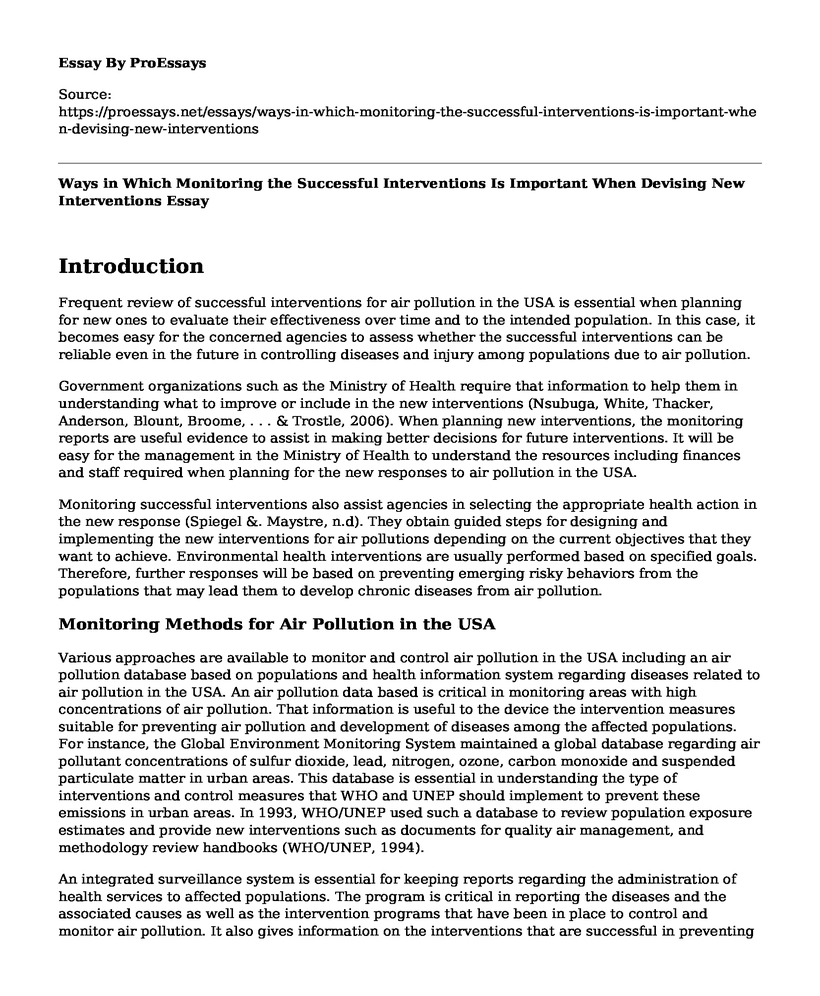Introduction
Frequent review of successful interventions for air pollution in the USA is essential when planning for new ones to evaluate their effectiveness over time and to the intended population. In this case, it becomes easy for the concerned agencies to assess whether the successful interventions can be reliable even in the future in controlling diseases and injury among populations due to air pollution.
Government organizations such as the Ministry of Health require that information to help them in understanding what to improve or include in the new interventions (Nsubuga, White, Thacker, Anderson, Blount, Broome, . . . & Trostle, 2006). When planning new interventions, the monitoring reports are useful evidence to assist in making better decisions for future interventions. It will be easy for the management in the Ministry of Health to understand the resources including finances and staff required when planning for the new responses to air pollution in the USA.
Monitoring successful interventions also assist agencies in selecting the appropriate health action in the new response (Spiegel &. Maystre, n.d). They obtain guided steps for designing and implementing the new interventions for air pollutions depending on the current objectives that they want to achieve. Environmental health interventions are usually performed based on specified goals. Therefore, further responses will be based on preventing emerging risky behaviors from the populations that may lead them to develop chronic diseases from air pollution.
Monitoring Methods for Air Pollution in the USA
Various approaches are available to monitor and control air pollution in the USA including an air pollution database based on populations and health information system regarding diseases related to air pollution in the USA. An air pollution data based is critical in monitoring areas with high concentrations of air pollution. That information is useful to the device the intervention measures suitable for preventing air pollution and development of diseases among the affected populations. For instance, the Global Environment Monitoring System maintained a global database regarding air pollutant concentrations of sulfur dioxide, lead, nitrogen, ozone, carbon monoxide and suspended particulate matter in urban areas. This database is essential in understanding the type of interventions and control measures that WHO and UNEP should implement to prevent these emissions in urban areas. In 1993, WHO/UNEP used such a database to review population exposure estimates and provide new interventions such as documents for quality air management, and methodology review handbooks (WHO/UNEP, 1994).
An integrated surveillance system is essential for keeping reports regarding the administration of health services to affected populations. The program is critical in reporting the diseases and the associated causes as well as the intervention programs that have been in place to control and monitor air pollution. It also gives information on the interventions that are successful in preventing or minimizing air pollution. An integrated surveillance system was used by the Philippine National Epidemic Surveillance System in 1980 and 1980 to detect outbreaks in the population, the flow of data in the hospital and staff requirements for monitoring the surveillance system. By using the health management information system, the Department of Health in Philippine was able to prevent outbreaks of diseases and staff incompetencies (White & McDonnell, 2000). Therefore, by having a similar health management system, the Department of Health in the USA can prevent air pollution by analyzing disease epidemiology dues to air pollution and implement the necessary interventions to stop the environmental hazard.
References
Nsubuga, P., White, M., Thacker, S., Anderson, M., Blount, S., Broome, C.., . . . & Trostle, M. (2006). Chapter 53: Public health surveillance: A tool for targeting and monitoring interventions. Retrieved from http://www.ncbi.nlm.nih.gov/books/NBK11770/
Spiegel, J., & Maystre, L. (n.d). Chapter 55 - Environmental Pollution Control and prevention. Encyclopedia of occupational health and safety. 4th Ed. Retrieved from the International Labor Office http://www.ilocis.org/documents/chpt55e.htm
White, M., &. McDonnell, S. (2000). Public Health Surveillance in Low and Middle-Income Countries. In Principles and Practices of Public Health Surveillance, ed. S. M. Teutsch, and R. E. Churchill, 287-315. New York: Oxford University Press.
World Health Organization (WHO) and United Nations Environmental Programme (UNEP). (1994). GEMS/AIR methodology reviews handbook series. 1-4. Quality Insurance in Urban Air Quality Monitoring, Geneva: WHO.
Cite this page
Ways in Which Monitoring the Successful Interventions Is Important When Devising New Interventions. (2022, Apr 04). Retrieved from https://proessays.net/essays/ways-in-which-monitoring-the-successful-interventions-is-important-when-devising-new-interventions
If you are the original author of this essay and no longer wish to have it published on the ProEssays website, please click below to request its removal:
- Corporate Social Responsibility (CSR) for Business in the Manufacturing Industry to Curb Climate Change
- Aviation Environmental Issues Essay
- Developed Countries Have Higher Responsibility Towards Global Climate Change
- Annotated Bibliography on Technology and Environment
- Response to Hurricane Katrina vs. Sandy
- Global Warming: Understanding Its Effects on Our Environment - Essay Sample
- Paper Example on East African Locust Crisis: A Growing Plague







